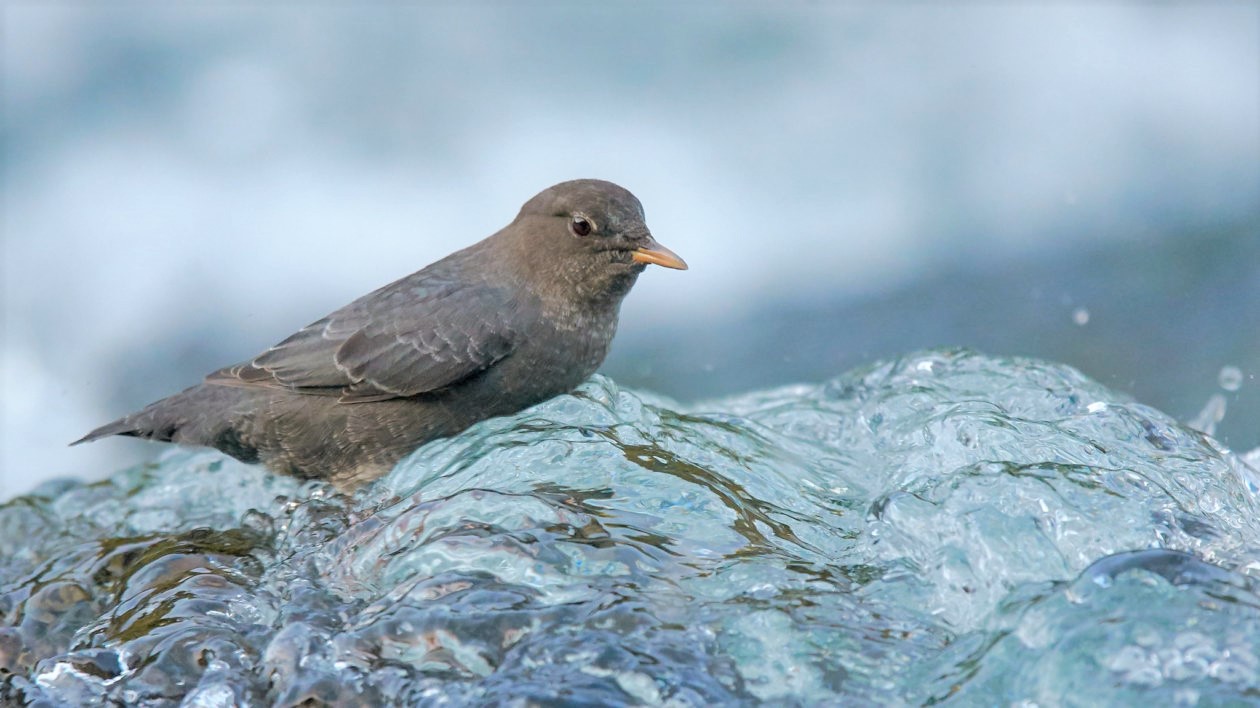By Justine E. Hausheer
Contributing Writer

I’m snowshoeing through Colorado’s Rocky Mountains when I see a small, nondescript bird at the far edge of the creek. I look down to adjust my binoculars, fumbling with my gloves. When I look up again, the bird is gone.
Water ripples along the ice-edged creek. The wind rattles bare aspen branches. There’s no sign of the bird.
Then a dark shape rockets out of the water onto the ice. Oh. That’s where the bird went. It devours its prey, does a quick bob-and-shake move and then dives back into the creek.
I’ve just found an American dipper, a chunky, lively aquatic songbird of the American west. Yes, that’s right. Aquatic songbird.
American dippers are oddballs of the passerine world. Along with the four other species in their genus, Cinclus, they’re the world’s only aquatic songbirds or passerines. They’re sometimes known as water ouzels.
American dippers are small and chunky, about the side of a robin, with grey-blue plumage, a brownish head, pink legs, a short tail and a white eyelid. Males and females look the same while juveniles are a dull grey, without any blue tones.
They’re found in high-altitude areas of the west, including Alaska, the Rocky Mountain states and down through Central America along the spine of the Sierra Madre. In the US, dippers are altitudinal migrants, meaning that instead of migrating across continents, they move up and down a mountain with the seasons. In summer they spread across the higher elevations to breed, but as the winter cold closes in they retreat to lower-elevation streams with free-flowing water.
Once you see a dipper, you immediately understand why they’re called “dippers.” These birds never seem to sit still. Even while scurrying along a creek, they’re constantly bobbing and dipping their bodies up and down like an endearing nervous twitch. One photographer observing dippers noted that the adults bob around 50 times per minute when they’re excited, disturbed, courting other dippers or feeding.
The dipping, and their habit of dunking themselves into nearby streams, makes them easy to identify — if you can find them.
A dipper’s diet is all things aquatic. If it’s found in a mountain stream and is small enough, there’s a good chance that a dipper will eat it. Aquatic insects and their larvae, including mayflies, mosquitoes, and midges, are favorite dipper foods. They will also consume small fish, fish eggs, dragonflies and worms.
Dippers employ a variety of foraging strategies. They will walk along the water’s edge like a heron, plucking prey from the shallows. Sometimes dippers forage by standing on a rock in the middle of the stream and dunking their head into the depths (my favorite). They will also dive underwater or beneath ice, either swimming with their wings or walking along the stream bottom in search of prey.
None of this would be possible without a few nifty adaptations. To survive cold mountain winters, dippers have low metabolic rates, thick down feathers and the ability to carry extra oxygen in their blood. They also have nostril flaps to keep water out.
Many people assume that their conspicuous white eyelid is a special membrane to help them see underwater, but it’s just a normal bird eyelid with white feathers. (Scientists aren’t quite sure why their eyelids are a different color.)
Adult dippers have an unusual molting pattern. Unlike other birds, which lose one or two feathers at a time, adult dippers molt all of their flight feathers simultaneously. This usually occurs around August after breeding. The birds are flightless for about two weeks as they regrow new plumage.
So the next time you head out to explore winter’s snowy stillness, keep your eyes peeled for the delightful dipper. You won’t be disappointed.
Justine E. Hausheer is an award-winning science writer for The Nature Conservancy, covering the innovative research conducted by the Conservancy’s scientists in the Asia Pacific region. She has a degree from Princeton University and a master’s in Science, Health, and Environmental Reporting from New York University. Justine’s favorite stories take her into pristine forests, desolate deserts or far-flung islands to report on field research as it’s happening. When not writing, you can find her traipsing after birds, attempting to fish and exploring the wild places around her home in Brisbane, Australia.


